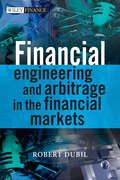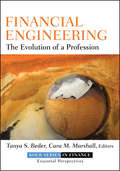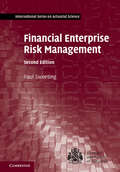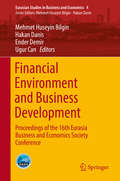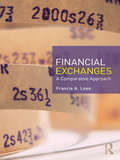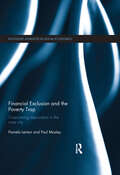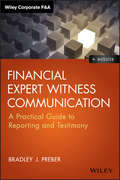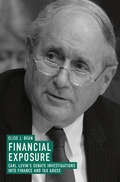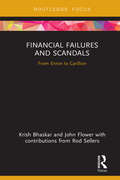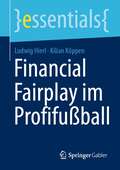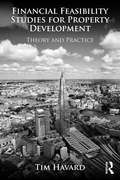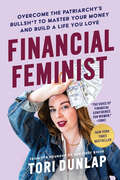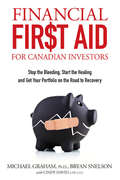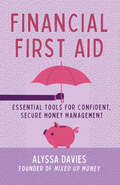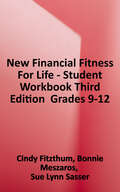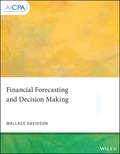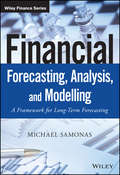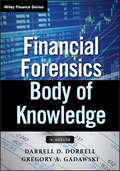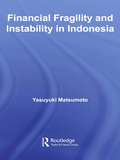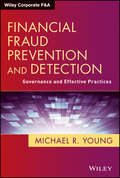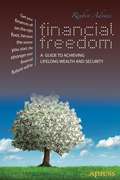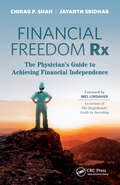- Table View
- List View
Financial Engineering and Arbitrage in the Financial Markets
by Robert DubilA whole is worth the sum of its parts. Even the most complex structured bond, credit arbitrage strategy or hedge trade can be broken down into its component parts, and if we understand the elemental components, we can then value the whole as the sum of its parts. We can quantify the risk that is hedged and the risk that is left as the residual exposure. If we learn to view all financial trades and securities as engineered packages of building blocks, then we can analyze in which structures some parts may be cheap and some may be rich. It is this relative value arbitrage principle that drives all modern trading and investment.This book is an easy-to-understand guide to the complex world of today's financial markets teaching you what money and capital markets are about through a sequence of arbitrage-based numerical illustrations and exercises enriched with institutional detail. Filled with insights and real life examples from the trading floor, it is essential reading for anyone starting out in trading.Using a unique structural approach to teaching the mechanics of financial markets, the book dissects markets into their common building blocks: spot (cash), forward/futures, and contingent (options) transactions. After explaining how each of these is valued and settled, it exploits the structural uniformity across all markets to introduce the difficult subjects of financially engineered products and complex derivatives.The book avoids stochastic calculus in favour of numeric cash flow calculations, present value tables, and diagrams, explaining options, swaps and credit derivatives without any use of differential equations.
Financial Engineering and Computation
by Yuh-Dauh LyuuNowadays students and professionals intending to work in any area of finance must master not only advanced concepts and mathematical models but also learn how to implement these models computationally. This comprehensive text combines the theory and mathematics behind financial engineering with an emphasis on computation, in keeping with the way financial engineering is practiced in today's capital markets. Unlike most books on investments, financial engineering, or derivative securities, the book starts from very basic ideas in finance and gradually builds up the theory. It offers a thorough grounding in the subject for MBAs in finance, students of engineering and sciences who are pursuing a career in finance, researchers in computational finance, system analysts, and financial engineers. Along with the theory, the author presents numerous algorithms for pricing, risk management, and portfolio management. The emphasis is on pricing financial and derivative securities: bonds, options, futures, forwards, interest rate derivatives, mortgage-backed securities, bonds with embedded options, and more. Each instrument is treated in a short, self-contained chapter for ready reference use. Many of these algorithms are coded in Java as programs for the Web, available from the book's home page (www. csie. ntu. edu/~lyuu/Capitals/capitals. htm)
Financial Engineering for Low-Income Households
by Amit Shah Bindu AnanthFinancial Engineering for Low-Income Households is an edited compilation of articles that focus on using financial engineering-a multidisciplinary field that uses technical methods from the fields of finance, mathematics and economics-to design financial services for low-income households. The book aims to provide an understanding of the various risk-reward trade-offs facing low-income households and how principles of financial engineering can be best applied to understand and manage the complete suite of financial and non-financial assets, including human capital, insurance, annuities and loans. This compilation connects the fundamental concepts in finance and financial engineering with the relatively new field of financial services delivery to low-income households. Its applied nature will help the reader grasp the implications of theoretical principles in finance on practical product-design considerations. It has several illustrations, caselets, and exercises to facilitate learning and in order to develop a full understanding of the underlying concepts. The book will be a valuable tool for students and practitioners interested in the design and delivery of financial services to low-income households.
Financial Engineering: The Evolution of a Profession (Robert W. Kolb Series #2)
by Tanya Beder Cara M. MarshallFINANCIAL ENGINEERING The Robert W. Kolb Series in Finance is an unparalleled source of information dedicated to the most important issues in modern finance. Each book focuses on a specific topic in the field of finance and contains contributed chapters from both respected academics and experienced financial professionals. As part of the Robert W. Kolb Series in Finance, Financial Engineering aims to provide a comprehensive understanding of this important discipline by examining its fundamentals, the newest financial products, and disseminating cutting-edge research. A contributed volume of distinguished practitioners and academics, Financial Engineering details the different participants, developments, and products of various markets-from fixed income, equity, and derivatives to foreign exchange. Also included within these pages are comprehensive case studies that reveal the various issues associated with financial engineering. Through them, you'll gain instant insights from the stories of Countrywide (mortgages), Société Générale and Barings (derivatives), the Allstate Corporation (fixed income), AIG, and many others. There is also a companion website with details from the editors' survey of financial engineering programs around the globe, as well as a glossary of key terms from the book. Financial engineering is an evolving field in constant revision. Success, innovation, and profitability in such a dynamic area require being at the forefront of research as new products and models are introduced and implemented. If you want to enhance your understanding of this discipline, take the time to learn from the experts gathered here.
Financial Enterprise Risk Management
by Paul SweetingFinancial Enterprise Risk Management provides all the tools needed to build and maintain a comprehensive ERM framework. As well as outlining the construction of such frameworks, it discusses the internal and external contexts within which risk management must be carried out. It also covers a range of qualitative and quantitative techniques that can be used to identify, model and measure risks, and describes a range of risk mitigation strategies. Over 100 diagrams are used to help describe the range of approaches available, and risk management issues are further highlighted by various case studies. A number of proprietary, advisory and mandatory risk management frameworks are also discussed, including Solvency II, Basel III and ISO 31000:2009. This book is an excellent resource for actuarial students studying for examinations, for risk management practitioners and for any academic looking for an up-to-date reference to current techniques.
Financial Enterprise Risk Management: Financial Enterprise Risk Management (International Series on Actuarial Science)
by Paul SweetingFinancial Enterprise Risk Management provides all the tools needed to build and maintain a comprehensive ERM framework. As well as outlining the construction of such frameworks, it discusses the internal and external contexts within which risk management must be carried out. It also covers a range of qualitative and quantitative techniques that can be used to identify, model and measure risks, and describes a range of risk mitigation strategies. Over 100 diagrams are used to help describe the range of approaches available, and risk management issues are further highlighted by various case studies. A number of proprietary, advisory and mandatory risk management frameworks are also discussed, including Solvency II, Basel III and ISO 31000:2009. This book is an excellent resource for actuarial students studying for examinations, for risk management practitioners and for any academic looking for an up-to-date reference to current techniques.
Financial Environment and Business Development
by Mehmet Huseyin Bilgin Hakan Danis Ender Demir Ugur CanThis volume focuses on the latest findings concerning financial environment research and the effects on business. Major topics addressed range from finance-driven globalization, contagion risk transmission, financial sustainability, and bank efficiency, to oil price shocks and spot prices research. Further topics include family business, business valuation, public sector development and business organization in the globalized environment. This book features selected peer-reviewed articles from the 16th EBES conference in Istanbul, where over 270 papers were presented by 478 researchers from 56 countries.
Financial Exchanges: A Comparative Approach
by Francis A LeesThe recent global economic crisis has drawn a spotlight on the world of finance. Financial exchanges are changing, and this insightful, new book examines the manner and reasons for these changes. Financial Exchanges: A Comparative Approach offers an in-depth analysis of this sector. Surveying thirty different financial exchanges, including stock, derivative, commodity and offshore exchanges, this book examines the challenges they face and the ways in which they are adapting. The book includes a pertinent chapter on the dominance of derivatives, examining a number of derivative exchanges in detail. Taking in a host of international exchange powerhouses, including those in Hong Kong, Shanghai, London, New York and the Persian Gulf, this book will benefit students taking courses on financial markets and institutions, as well as professionals interested in international financial markets.
Financial Exclusion and the Poverty Trap: Overcoming Deprivation in the Inner City (Routledge Advances In Social Economics Ser. #17)
by Paul Mosley Pamela LentonThe persistence of poverty hurts us all, and attacking poverty is a major policy objective everywhere. In Britain, the main political parties have an anti-poverty mandate and in particular an agreed commitment to eliminate child poverty by 2020, but there is controversy over how this should be done. This book addresses one of the main causes of poverty, financial exclusion – the inability to access finance from the high-street banks. People on low or irregular incomes typically have to resort to loan sharks, ‘doorstep lenders’ and other informal credit sources, a predicament which makes escape from the poverty trap doubly difficult. Over the last fifteen years, a strategy of breaking down the poverty trap has been implemented, known in the UK as community development financial institutions (CDFIs), typically non-profit lending institutions focussed on the financially excluded, and seeking to learn from the achievements of microfinance around the world. Focussing on the period 2007-09, during which the UK went into a global recession, this book investigates how CDFIs work and how well they have helped low-income people and businesses to weather that recession. Based on a study of eight CDFIs in four UK cities, we ask: what ideas for overcoming financial exclusion have worked well, and which have worked badly? What can we learn from the experience of these CDFIs which can help reduce poverty in this country and globally? We assess the impact of CDFIs using a range of indicators (including income, assets, education, health) and ask what changes in policy by both CDFIs and government agencies (for example, benefits agencies) might be able to increase impact. Some of the key lessons are: CDFIs need to work with appropriate partners to build up savings capacity in their clients; the community environment is vital in determining who escapes from the poverty trap; and CDFIs can never function properly unless they learn how to control their overdue debts. This book will be vital reading for those concerned with social policy, microfinance and anti-poverty policies in industrialised countries and around the world.
Financial Expert Witness Communication: A Practical Guide to Reporting and Testimony (Wiley Corporate F&A)
by Bradley J. PreberLearn what to expect—and what's expected—as an expert witness Serving as a financial expert witness or consultant in lawsuits is a stressful, challenging, and tough business. In Financial Expert Witness Communication: A Practical Guide to Reporting and Testimony, financial forensic expert Bradley J. Preber leverages more than 30 years of experience to create a practical guide for financial expert witnesses as they face litigation reporting and testimony. Financial Expert Witness Communication covers all areas of financial litigation including accounting, financial forensics, forensic technology, and damages—all from the point of view of an expert witness. The book is especially helpful for those who expect to be formally designated as an expert witness; however, it is also appropriate for financial forensic accountants, litigation consultants, and attorneys as they navigate the unique playing field of the financial litigation process. This book gives financial experts strategies to defend the analysis, conclusions, and expert opinions they have at their disposal. It also provides thorough explanations of compliance, data limitations, and due diligence as well as how to handle demanding legal counsel, with a goal of better preparing them for the entire legal process. The book is part of the Wiley Corporate F&A Series and was created as an educational resource for nonattorney financial experts involved with U.S.-based civil litigation or alternative dispute resolution proceedings. It takes a well-rounded approach by including special chapters on such concepts as retention, privilege, responsibilities, ethics, and testimony, all written by a nationally recognized expert. As a bonus, the companion website presents an additional expert witness case study and guidelines for fulfilling an expert witness role.
Financial Exposure: Carl Levin's Senate Investigations Into Finance And Tax Abuse
by Elise J. BeanAt a time when Congressional investigations have taken on added importance and urgency in American politics, this book offers readers a rare, insider’s portrait of the world of US Congressional oversight. It examines specific oversight investigations into multiple financial and offshore tax scandals over fifteen years, from 1999 to 2014, when Senator Levin served in a leadership role on the US Senate Permanent Subcommittee on Investigations (PSI), the Senate’s premier investigative body. Despite mounting levels of partisanship, dysfunction, and cynicism swirling through Congress during those years, this book describes how Congressional oversight investigations can be a powerful tool for uncovering facts, building bipartisan consensus, and fostering change, offering detailed case histories as proof. Grounded in fact, and written as only an insider could tell it, this book will be of interest to financial and tax practitioners, policymakers, academics, students, and the general public.
Financial Failures and Scandals: From Enron to Carillion (Disruptions in Financial Reporting and Auditing)
by John Flower Krish BhaskarThis concise volume evaluates the cause and significance of recent corporate failures and financial scandals, and how they reflect on the fitness for purpose of the external auditors, financial reports, financial watchdogs, boards, directors and senior management. Failures like the disastrous collapse of Carillion, examined at length, have ultimately led to a crisis of confidence not only in the audit process but in the entire process of financial reporting. Revealing the shortcomings in audit quality, independence, choice and the growing expectation gap, Financial Failures and Scandals questions if the profession, its regulators or government watchdogs, are adequately prepared for the challenges of increasing regulation, public outcry and political scrutiny in the face of inevitable future financial failures. The fundamental structures of financial reporting, annual reports, boards of directors and senior management are often found to have failed. Tighter regulation and new requirements for reporting will inevitably result. Drawing on extensive research and interviews with insiders, users and experts, this unique book provides a compelling account of the profoundly disruptive impact of financial failures on corporate and financial accountability. Topical and readable, this book will be of great interest to students, researchers and professionals in accounting and auditing, as well as to policy makers and regulators.
Financial Fairplay im Profifußball (essentials)
by Ludwig Hierl Kilian KöppenIm Rahmen dieses essentials werden zunächst die Financial Fairplay-Regularien der UEFA in ihrer Ausgestaltung und Anwendung dargestellt. Mängel sind nicht erst seit den Sportgerichtshof-Urteilen gegen beziehungsweise für Manchester City und Paris Saint Germain offensichtlich. Von einer Überarbeitung bis hin zur Abschaffung werden zahlreiche Optionen zur Reformierung diskutiert, auch auf Seiten der UEFA, wobei viele Ansätze wie beispielsweise die Deckelung von Spielergehältern („Salary Caps“) oder Ablösesummen keinesfalls neu sind. Neu ist allerdings, dass sich die Einschätzung, ob hiermit gegen europäisches Recht verstoßen werden würde, verändert hat.
Financial Feasibility Studies for Property Development: Theory and Practice
by Tim HavardEssential for any real estate professional or student performing feasibility studies for property development using Microsoft Excel and two of the most commonly used proprietary software systems, Argus Developer and Estate Master DF.This is the first book to not only review the place of financial feasibility studies in the property development process, but to examine both the theory and mechanics of feasibility studies through the construction of user friendly examples using these software systems. The development process has seen considerable changes in practice in recent years as developers and advisors have adopted modern spread sheets and software models to carry out feasibility studies and appraisals. This has greatly extended their ability to model more complex developments and more sophisticated funding arrangements, saving time and improving accuracy.Tim Havard brings over 25 years of industry and software experience to guide students and practitioners through the theory of development appraisals and feasibility studies before providing internationally applicable worked examples and potential pitfalls using Excel, Argus Developer and Estates Master DF.
Financial Feminist: Overcome the Patriarchy's Bullsh*t to Master Your Money and Build a Life You Love
by Tori DunlapFinancial Feminist has descriptive copy which is not yet available from the Publisher.
Financial First Aid for Canadian Investors: Stop the Bleeding, Start the Healing and Get Your Portfolio on the Road to Recovery
by Michael Graham Bryan Snelson Cindy DavidPraise for the previous edition, Portfolio First Aid "I'd categorize Portfolio First Aid as a serious investment primer that has the laudable, if ambitious, goal of raising the sophistication level of the general public." —Jonathan Chevreau, Financial Post "Portfolio First Aid has the right pedigree as an advice tome on healthy investing. Covers the bases of portfolio balance, building wealth, investing for income and managing risk." —The Edmonton Journal The financial meltdown has taken a severe toll on the finances of Canadians, and on their confidence in financial and investment advisors. Canadians need help to learn how to diagnose what is the greatest threat to their long-term financial well-being and to follow a course of treatment to recovery. Financial First Aid for Canadian Investors is for all the battered and bloodied investors whose portfolios are in tatters and who lack direction about what to do next. By examining the lessons to be learned from mistakes made in both good and bad markets, the authors address the common and recurring investment blunders they have witnessed over many years, and offer a clear prescription for how to repair wounded portfolios.
Financial First Aid: Essential Tools for Confident, Secure Money Management
by Alyssa DaviesA practical guide for handling life's financial emergencies for the cash-strapped, the meticulous budgeter, and everyone in between. What do a layoff, a medical emergency, a broken appliance, and a natural disaster have in common? Each scenario has the potential to upend your personal finances, no matter your financial situation. Money can be an intense source of stress, especially when you suddenly don't have enough of it. This handy and accessible reference from Alyssa Davies, founder of the popular finance blog Mixed Up Money, is here to help you navigate these financial ups and downs with a judgment-free approach. It offers actionable advice for different types of emergencies, short- and long-term solutions, resources, and tips from well-known financial experts who have been there before. You'll find scripts for negotiating payments for large bills, and learn how to revise a budget if you need to care for a loved one who is sick, recognize financial abuse, and much more. Charming illustrations by the author add a touch of humor to her expert advice. Best practices for building a robust emergency fund and road maps for recovering from a financial emergency will help you face your next rainy day.
Financial Fitness for Life Student Workbook, Grades 9-12
by Bonnie Meszaros Scott Bacon Gail Colbert Cindy Fitzthum Sue Lynn SasserThis book is a CEE publication that helps teachers prepare students for life beyond the classroom by presenting materials based on real-world concepts in a way that reinforces learning through practice. The lesson plans within this collection have a description of the lesson, slides, and/or activities with educational technology tools such as Kahoot! and/or Quizlet. For full access to the book, shop for the Teacher Guide and Student Workbook.
Financial Forecasting and Decision Making (AICPA)
by Wallace Davidson IIIMany companies fail to succeed due to poor planning, which is one reason why CPA's are in big demand. Skilled at forecasting, CPAs can plan a company's future by determining the maximum sustainable growth and predict its external fund requirements. This course provides you with the basic tools necessary to project the balance sheet and statements of income and cash flow, enabling you to add a unique value to your client(s) work.
Financial Forecasting, Analysis and Modelling
by Michael SamonasRisk analysis has become critical to modern financial planningFinancial Forecasting, Analysis and Modelling provides a complete framework of long-term financial forecasts in a practical and accessible way, helping finance professionals include uncertainty in their planning and budgeting process. With thorough coverage of financial statement simulation models and clear, concise implementation instruction, this book guides readers step-by-step through the entire projection plan development process. Readers learn the tools, techniques, and special considerations that increase accuracy and smooth the workflow, and develop a more robust analysis process that improves financial strategy. The companion website provides a complete operational model that can be customised to develop financial projections or a range of other key financial measures, giving readers an immediately-applicable tool to facilitate effective decision-making.In the aftermath of the recent financial crisis, the need for experienced financial modelling professionals has steadily increased as organisations rush to adjust to economic volatility and uncertainty. This book provides the deeper level of understanding needed to develop stronger financial planning, with techniques tailored to real-life situations.Develop long-term projection plans using ExcelUse appropriate models to develop a more proactive strategyApply risk and uncertainty projections more accuratelyMaster the Excel Scenario Manager, Sensitivity Analysis, Monte Carlo Simulation, and moreRisk plays a larger role in financial planning than ever before, and possible outcomes must be measured before decisions are made. Uncertainty has become a critical component in financial planning, and accuracy demands it be used appropriately. With special focus on uncertainty in modelling and planning, Financial Forecasting, Analysis and Modelling is a comprehensive guide to the mechanics of modern finance.
Financial Forensics Body of Knowledge
by Darrell D. Dorrell Gregory A. GadawskiThe definitive, must-have guide for the forensic accounting professional Financial Forensics Body of Knowledge is the unique, innovative, and definitive guide and technical reference work for the financial forensics and/or forensic accounting professional, including nearly 300 forensic tools, techniques, methods and methodologies apply to virtually all civil, criminal and dispute matters. Many of the tools have never before been published. It defines the profession: "The Art & Science of Investigating People & Money. " It defines Forensic Operators: ". . . financial forensics-capable personnel. . . possess unique and specific skills, knowledge, experience, education, training, and integrity to function in the financial forensics discipline. " It defines why: "If you understand financial forensics you understand fraud, but not vice versa" by applying financial forensics to all aspects of the financial community. It contains a book-within-a-book Companion Section for financial valuation and litigation specialists. It defines foundational financial forensics/forensic accounting methodologies: FAIM, Forensic Accounting Investigation Methodology, ICE/SCORE, CICO, APD, forensic lexicology, and others. It contains a Reader Lookup Table that permits everyone in the financial community to immediately focus on the pertinent issues.
Financial Fragility and Instability in Indonesia (Routledge Contemporary Southeast Asia Series #2)
by Yasuyuki MatsumotoThis highly relevant study provides an incisive analysis of a critical phase in recent East Asian financial history, exploring the underlying causes of the financial crisis that struck Indonesia during the second half of 1997. Matsumoto’s extensive commercial experience in Indonesian finance during these critical years, allows him to skilfully argue that the roots of the crisis lay in the period of capital liberalization undertaken during the boom years from 1994 to 1997 which encouraged the development of fragile and unstable financial structures, involving increased corporate leverage, reliance on external debt, and the introduction of riskier and more complicated financial instruments and transactions. In-depth fieldwork data and four detailed case studies illuminate the microeconomic foundations of the crisis, showing how Indonesian capitalists sought to liquidate their Indonesian assets without losing control of their corporate empires, by taking advantage of increased access to foreign loans and complex financial re-engineering, actions which ultimately precipitated instability and crisis throughout the entire financial system. Finally, it reflects upon the policy implications of this episode, putting forward the case for comprehensive capital controls for open and developing economies until they establish appropriate financial institutions to monitor and manage the level of indebtedness and the volatility of capitalists’ behaviour.
Financial Fraud Prevention and Detection: Governance and Effective Practices (Wiley Corporate F&A)
by Michael R. YoungStep-by-step guidance for board members and executives on preventing and detecting accounting fraud In the wake of highly publicized allegations of accounting irregularities and fraudulent financial reporting that are shaking up today's corporate community, Financial Fraud Prevention and Detection provides a step-by-step guide to how these crises can envelop a company and how to prevent them from happening in the first place. It is written for almost everyone involved: outside directors, audit committee members, senior executives, CFOs, CPAs, in-house lawyers, and outside law firms. Provides a blueprint for Fraud Prevention and Detection for corporate executives Presents step-by-step guidance to corporate boards and C-suite executives on managing the threat of accounting fraud Prepares directors and executives for the possibility of accounting irregularities Answers the question of how accounting fraud starts—and grows With solid strategies for prevention of accounting fraud as well as a process to follow when fraud has been discovered, Financial Fraud Prevention and Detection vividly explores the corporate environment that causes fraud, how it spreads, the kind of crises it can create for a company, and the best ways to deal with it.
Financial Freedom
by Reuben AdvaniProblem-Solving and Selected Topics in Euclidean Geometry: ?in the Spirit of the Mathematical Olympiads'' contains theorems which are of particular value for the solution of geometrical problems. Emphasis is given in the discussion of a variety of methods, which play a significant role for the solution of problems in Euclidean Geometry. Before the complete solution of every problem, a key idea is presented so that the reader will be able to provide the solution. Applications of the basic geometrical methods which include analysis, synthesis, construction and proof are given. Selected problems which have been given in mathematical olympiads or proposed in short lists in IMO''s are discussed. In addition, a number of problems proposed by leading mathematicians in the subject are included here. The book also contains new problems with their solutions. The scope of the publication of the present book is to teach mathematical thinking through Geometry and to provide inspiration for both students and teachers to formulate ''positive'' conjectures and provide solutions.
Financial Freedom Rx: The Physician’s Guide to Achieving Financial Independence
by Chirag Shah Jayanth Sridhar"The best physician-specific general financial book published in 2021." —James M. Dahle, MD, author of The White Coat InvestorA step-by-step guidebook for doctors and other medical professionals about growing and preserving wealth, Financial Freedom Rx: The Physician’s Guide to Achieving Financial Independence gives physicians all the tools necessary to manage their own finances and includes a foreword by Mel Lindauer, co-author of The Bogleheads' Guide to Investing. Medical professionals, especially doctors, spend many years in training as they accumulate debt and delay their earnings. This book presents a time-tested formula that students and established professionals can follow at any stage during their careers to achieve fiscal peace of mind. Students will learn how to budget and adopt disciplined financial practices. Residents and other trainees will learn how to defend against calamity with various insurances and how to manage debt. Junior professionals will acquire the skills needed to invest and grow their portfolios, while senior professionals will better understand the essentials of estate planning and retirement. Drs. Chirag P. Shah and Jayanth Sridhar wrote this inspiring text to guide physicians where to put their next dollar. This is particularly important during the financial uncertainties brought on by COVID-19 and insurance cuts. Financial Freedom Rx sets forth principles that will pilot medical professionals toward financial independence. Chapters include useful advice on topics such as: Financial planning Investing and asset allocation Jobs and contracts Taxes and insurance Student loans and debt Retirement savings and distributions Financial Freedom Rx: The Physician’s Guide to Achieving Financial Independence serves as a timeless blueprint for financial planning that medical professionals will follow throughout their careers, and as a reference that readers will revisit again and again as they progress through the various stages of life.
